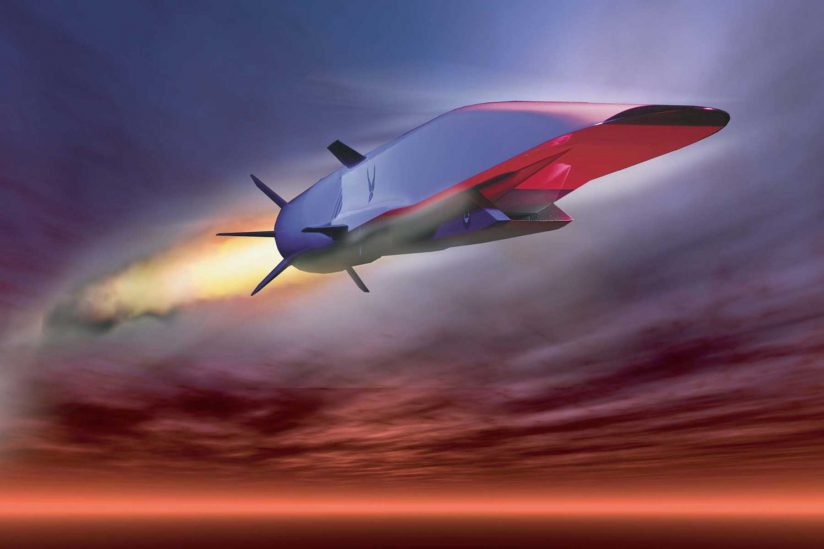
Scramjet technology enables a vehicle to reach hypersonic speeds in flight. Here is a USAF artist rendering of an X-51A Waverider.
Warning that many countries could have hypersonic weapons within 10 years—and that there is currently no defense against them—a quartet of specialists from the RAND Corporation are urging the US, Russia, and China to adopt policies that would restrict the transfer of hypersonic technologies and components to other nations. They argued that there is still time to control hypersonic proliferation and that the “big three” have incentive to do so.
RAND presented the proposal and an accompanying white paper—“Hypersonic Missile Nonproliferation”—at its Arlington, Va., offices on Sept. 27. The work was underwritten by the Carnegie Corp. of New York.
Study authors said they had discussed the proposal with US government officials but declined to say who. A Pentagon nonproliferation official present at the study rollout told Air Force Magazine that after speaking with the authors, “I’m satisfied they’re talking to the right people.” The authors said the nonproliferation effort might work best if it was added to the Missile Technology Control Regime, although they acknowledged that China is not bound by that agreement.
There are two kinds of potential weapons in the Mach 5+ category: Hypersonic Cruise Missiles and Hypersonic Glide Vehicles. Both fly at relatively low altitudes—exo-atmospheric—and at speeds that existing missile defense systems can’t intercept. Proliferation of such weapons would be destabilizing because of their ability to rapidly decapitate an adversary’s leadership or offensive capabilities, in turn giving the intended target the incentive to pre-empt the attack, faced with a “use-it-or-lose-it” situation. Hypersonic missiles can also fly so fast that the defending country would not be able to determine the intended target until the last few seconds of flight, making point defense impossible.
“It’s in their interest” to control such technology, Richard Speir said of the US, Russia, and China. “They don’t want their neighbors to have this. But there’s not a lot of time.” He said the countries with the most advanced hypersonic technology outside the “big three” could have practical weapon “in several years.” Among them are France, Britain, Australia, India, and Iran.
Having the ability to threaten the major powers, even with a small number of hypersonic weapons, “emboldens lesser powers” like North Korea, to use them, study author George Nacouzi said. This, in turn, “lowers the threshold” for a conflict escalating to nuclear weapons because of the damage hypersonic weapons can do. Even without a warhead, a hypersonic missile’s kinetic energy could pack a punch measured in single-digit kilotons.
There’s time to achieve a nonproliferation regime because the entry cost of designing, building, and testing hypersonic weapons is still quite high, author Richard Moore said. A hypersonic weapon requires highly sophisticated propulsion technology and flight controls; materials able to withstand extreme heat and temperature differentials around the missile—“every millimeter of which” is critical to its proper functioning, Moore said—and the facilities available to test such a weapon are hard to build and most can only test for durations of a few thousandths of a second. France, in fact, has an agreement with Russia to use Russia’s facilities and ranges for France’s LEA test vehicle, Moore noted.
The authors proposed restricting “whole missiles … and major subcomponents,” as well as access to reentry vehicles and warheads. Some of the things to be considered on a “case-by-case basis” might be fuels, sensors, and navigation, flight controls, engines, design tools, and simulation devices, and materials relevant to hypersonic weapons.
The MTCR is the “most promising” vehicle for an agreement, Speir asserted. Crafting a deal from scratch would probably be “very time consuming” and be overtaken by events. However, the MTCR’s definitions of what constitutes a controlled technology may have “loopholes” that a hypersonic weapon could slip through.
A challenge to be overcome is that a number of countries are developing hypersonics for commercial purposes, as a bridge to high-speed transports or airliners. Some countries also see hypersonics as a way to stimulate their indigenous aerospace industries, and certainly as a way to challenge or defend against nations more militarily powerful than themselves.
Asked what “the next steps” are, Speier said, “We’ve taken one today” with the release of the report, to be followed by meetings and briefings with “embassies, nonprofits, and the media” to socialize the idea. It will only become “more difficult” to achieve a deal as time goes by, he said. Still, “We have a few years.”